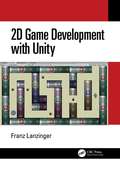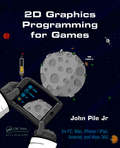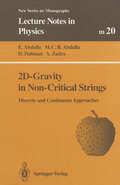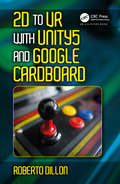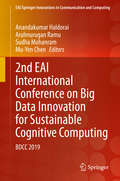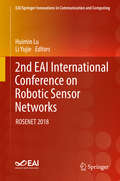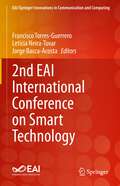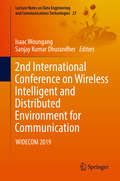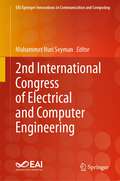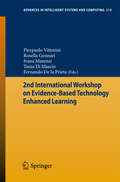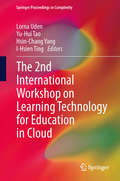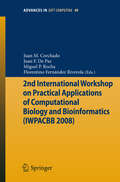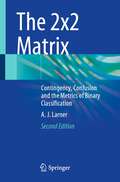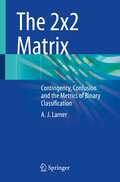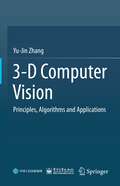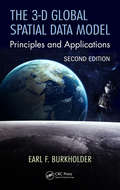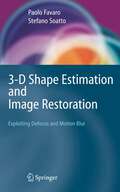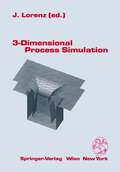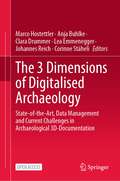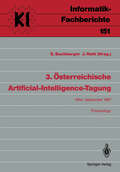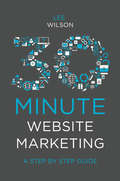- Table View
- List View
2D Game Development with Unity
by Franz LanzingerThis book teaches beginners and aspiring game developers how to develop 2D games with Unity. Thousands of commercial games have been built with Unity. The reader will learn the complete process of 2D game development, step by step. The theory behind each step is fully explained. This book contains numerous color illustrations and access to all source code and companion videos. Key Features: Fully detailed game projects from scratch. Beginners can do the steps and create games right away. No coding experience is necessary. Numerous examples take a raw beginner toward professional coding proficiency in C# and Unity. Includes a thorough introduction to Unity 2020, including 2D game development, prefabs, cameras, animation, character controllers, lighting, and sound. Includes a step-by-step introduction to Unity 2019.3. Extensive coverage of GIMP, Audacity, and MuseScore for the creation of 2D graphics, sound effects, and music. All required software is free to use for any purpose including commercial applications and games. Franz Lanzinger is the owner and chief game developer of Lanzinger Studio, an independent game development and music studio in Sunnyvale, California. He started his career in game programming in 1982 at Atari Games, Inc., where he designed and programmed the classic arcade game Crystal Castles. In 1989, he joined Tengen, where he was a programmer and designer for Ms. Pac-Man and Toobin' on the NES. He co-founded Bitmasters, where he designed and coded games including Rampart and Championship Pool for the NES and SNES, and NCAA Final Four Basketball for the SNES and Sega Genesis. In 1996, he founded Actual Entertainment, publisher and developer of the Gubble video game series. He has a B.Sc. in mathematics from the University of Notre Dame and attended graduate school in mathematics at the University of California at Berkeley. He is a former world record holder on Centipede and Burgertime. He is a professional author, game developer, accompanist, and piano teacher. He is currently working on remaking the original Gubble game in Unity and Blender.
2D Game Development with Unity
by Franz LanzingerThis book teaches beginners and aspiring game developers how to develop 2D games with Unity. Thousands of commercial games have been built with Unity. The reader will learn the complete process of 2D game development, step by step. The theory behind each step is fully explained. This book contains numerous color illustrations and access to all source code and companion videos. Key Features: Fully detailed game projects from scratch. Beginners can do the steps and create games right away. No coding experience is necessary. Numerous examples take a raw beginner toward professional coding proficiency in C# and Unity. Includes a thorough introduction to Unity 2020, including 2D game development, prefabs, cameras, animation, character controllers, lighting, and sound. Includes a step-by-step introduction to Unity 2019.3. Extensive coverage of GIMP, Audacity, and MuseScore for the creation of 2D graphics, sound effects, and music. All required software is free to use for any purpose including commercial applications and games. Franz Lanzinger is the owner and chief game developer of Lanzinger Studio, an independent game development and music studio in Sunnyvale, California. He started his career in game programming in 1982 at Atari Games, Inc., where he designed and programmed the classic arcade game Crystal Castles. In 1989, he joined Tengen, where he was a programmer and designer for Ms. Pac-Man and Toobin' on the NES. He co-founded Bitmasters, where he designed and coded games including Rampart and Championship Pool for the NES and SNES, and NCAA Final Four Basketball for the SNES and Sega Genesis. In 1996, he founded Actual Entertainment, publisher and developer of the Gubble video game series. He has a B.Sc. in mathematics from the University of Notre Dame and attended graduate school in mathematics at the University of California at Berkeley. He is a former world record holder on Centipede and Burgertime. He is a professional author, game developer, accompanist, and piano teacher. He is currently working on remaking the original Gubble game in Unity and Blender.
2D Graphics Programming for Games
by John Pile Jr.The success of Angry Birds, Peggle, and Fruit Ninja has proven that fun and immersive game experiences can be created in two dimensions. Furthermore, 2D graphics enable developers to quickly prototype ideas and mechanics using fewer resources than 3D.2D Graphics Programming for Games provides an in-depth single source on creating 2D graphics that c
2D-Gravity in Non-Critical Strings: Discrete and Continuum Approaches (Lecture Notes in Physics Monographs #20)
by E. Abdalla M.C.B. Abdalla D. Dalmazi A. ZadraA comprehensive survey of the use of the Liouville (and super-Liouville) equation in (super)string theory outside the critical dimension, and of the complementary approach based on the discretized space-time - known as the matrix model approach. The authors pay particular attention to supersymmetry, both in the continuum formulation and through the consideration of the super-eigenvalue problem. The methods presented here are important in a large number of complex problems, e.g. random surfaces, 2-D gravity and large-N quantum chromodynamics, and this comparitive study of the different methods permits a cross-evaluation of the results when both methods are valid, combined with new predictions when only one of the methods may be applied.
2D to VR with Unity5 and Google Cardboard
by Roberto DillonThe book provides an up-to-date introduction to the latest version of Unity and its workflow by guiding readers through various prototypes. These range from 2D to 3D game concepts for PC and mobile, will allow readers to get acquainted with several important concepts and allow them to become competent Unity developers able to learn at their own pace. The book starts by introducing Unity and proceeds in building a basic understanding of its main components by developing a first, simple 2D game before proceeding in developing a full casual game to development of a simple but immersive 3D game concept to be tested first on PC before exploring how to port it for mobile VR.using Google Cardboard.
2D to VR with Unity5 and Google Cardboard
by Roberto DillonThe book provides an up-to-date introduction to the latest version of Unity and its workflow by guiding readers through various prototypes. These range from 2D to 3D game concepts for PC and mobile, will allow readers to get acquainted with several important concepts and allow them to become competent Unity developers able to learn at their own pace. The book starts by introducing Unity and proceeds in building a basic understanding of its main components by developing a first, simple 2D game before proceeding in developing a full casual game to development of a simple but immersive 3D game concept to be tested first on PC before exploring how to port it for mobile VR.using Google Cardboard.
2nd EAI International Conference on Big Data Innovation for Sustainable Cognitive Computing: BDCC 2019 (EAI/Springer Innovations in Communication and Computing)
by Anandakumar Haldorai Arulmurugan Ramu Sudha Mohanram Mu-Yen ChenThis proceeding features papers discussing big data innovation for sustainable cognitive computing. The papers feature details on cognitive computing and its self-learning systems that use data mining, pattern recognition and natural language processing (NLP) to mirror the way the human brain works. This international conference focuses on cognitive computing technologies, from knowledge representation techniques and natural language processing algorithms to dynamic learning approaches. Topics covered include Data Science for Cognitive Analysis, Real-Time Ubiquitous Data Science, Platform for Privacy Preserving Data Science, and Internet-Based Cognitive Platform. The 2nd EAI International Conference on Big Data Innovation for Sustainable Cognitive Computing (BDCC 2019) took place in Coimbatore, India on December 12-13, 2019.Contains proceedings from 2nd EAI International Conference on Big Data Innovation for Sustainable Cognitive Computing (BDCC 2019), Coimbatore, India, December 12-13, 2019;Features topics ranging from Data Science for Cognitive Analysis to Internet-Based Cognitive Platforms;Includes contributions from researchers, academics, and professionals from around the world.
2nd EAI International Conference on Robotic Sensor Networks: ROSENET 2018 (EAI/Springer Innovations in Communication and Computing)
by Huimin Lu Li YujieThis book provides scientific research into Cognitive Internet of Things for Smart Society, with papers presented at the 2nd EAI International Conference on Robotic Sensor Networks. The conference explores the integration of networks and robotic technologies, which has become a topic of increasing interest for both researchers and developers from academic fields and industries worldwide. The authors posit that big networks will be the main approach to the next generation of robotic research, with the explosive number of networks models and increasing computational power of computers significantly extending the number of potential applications for robotic technologies while also bringing new challenges to the network's community. The 2nd EAI International Conference on Robotic Sensor Networks was held 25-26 August 2018 at the Kitakyushu International Conference Center (MICE), Kitakyushu, Japan.
2nd EAI International Conference on Smart Technology (EAI/Springer Innovations in Communication and Computing)
by Francisco Torres-Guerrero Leticia Neira-Tovar Jorge Bacca-AcostaThis book presents the proceedings of 2nd EAI International Conference on Smart Technology (MTYMEX), which took place April 27th, 2021, online and in Monterrey, Mexico. MTYMEX is an international conference aimed at demonstrating the potential of new applications for the Internet in the future. The authors offer perspectives on research on smart technologies in society, including the results of research projects on virtual reality, blockchain, artificial intelligence, and smart cities. The book offers examples of applications with smart technologies in different knowledge areas. The conference brings together the academic, research and private sectors working on applications and smart devices for e-health and smart cities.
2nd International Conference on Wireless Intelligent and Distributed Environment for Communication: WIDECOM 2019 (Lecture Notes on Data Engineering and Communications Technologies #27)
by Isaac Woungang Sanjay Kumar DhurandherThis book presents the proceedings of the International Conference on Wireless Intelligent and Distributed Environment for Communication (WIDECOM 2019), sponsored by the University of Milan, Milan, Italy, February 11-13, 2019. The conference deals both with the important core and the specialized issues in the areas of new dependability paradigms design and performance of dependable network computing and mobile systems, as well as issues related to the security of these systems. The WIDECOM proceedings features papers addressing issues related to the design, analysis, and implementation, of infrastructures, systems, architectures, algorithms, and protocols that deal with network computing, mobile/ubiquitous systems, cloud systems, and IoT systems. It is a valuable reference for researchers, instructors, students, scientists, engineers, managers, and industry practitioners. The book’s structure and content is organized in such a manner that makes it useful at a variety of learning levels.Presents the proceedings of the International Conference on Wireless Intelligent and Distributed Environment for Communication (WIDECOM 2019), Milan, Italy, February 11-13, 2019;Includes an array of topics networking computing, mobile/ubiquitous systems, cloud systems, and IoT systems;Addresses issues related to protecting information security and establishing trust in the digital space.
2nd International Congress of Electrical and Computer Engineering (EAI/Springer Innovations in Communication and Computing)
by Muhammet Nuri SeymanThis proceedings presents the papers included in the 2nd International Congress of Electrical and Computer Engineering (ICECENG), which took place in Bandirma, Turkey, 22-25 November 2023. The conference aims to bring together researchers, developers, and students in computing, technology trends, artificial intelligence, and security who are interested in studying the application of formal methods to the construction and analysis of models describing technological processes at both micro and macro levels. ICECENG’23 also aims to provide a platform for discussing the issues, challenges, opportunities, and findings of computer engineering research. The conference seeks to provide some answers and explore the processes, actions, challenges, and outcomes of learning and teaching.
2nd International Workshop on Evidence-based Technology Enhanced Learning (Advances in Intelligent Systems and Computing #218)
by Pierpaolo Vittorini Rosella Gennari Ivana Marenzi Tania Di Mascio Fernando De La PrietaResearch on Technology Enhanced Learning (TEL) investigates how information and communication technologies can be designed in order to support pedagogical activities. The Evidence Based Design (EBD) of a system bases its decisions on empirical evidence and effectiveness. The evidence-based TEL workshop (ebTEL) brings together TEL and EBD. The first edition of ebTEL collected contributions in the area of TEL from computer science, artificial intelligence, evidence-based medicine, educational psychology and pedagogy. Like the previous edition, this second edition, ebTEL’13, wants to be a forum in which TEL researchers and practitioners alike can discuss innovative evidence-based ideas, projects, and lessons related to TEL. The workshop took place in Salamanca, Spain, on May 22nd-24th 2013.
The 2nd International Workshop on Learning Technology for Education in Cloud (Springer Proceedings in Complexity)
by Lorna Uden Yu-Hui Tao Hsin-Chang Yang I-Hsien TingProceedings from the 2013 LTEC conference in Kaohsiung, Taiwan. The papers examine diverse aspects of Learning Technology for Education in Cloud environments, including social, technical and infrastructure implications. Also addressed is the question of how cloud computing can be used to design applications to support real time on demand learning using technologies. The workshop proceedings provide opportunities for delegates to discuss the latest research in TEL (Technology Enhanced Learning) and its impacts for learners and institutions, using cloud technologies.
2nd International Workshop on Practical Applications of Computational Biology and Bioinformatics (Advances in Intelligent and Soft Computing #49)
by Francisco De Paz Miguel P. Rocha Florentino Fernández Riverola Juan Manuel Corchado RodríguezThe success of Bioinformatics in recent years has been prompted by research in mole- lar biology and medicine in initiatives like the human genome project. The volume and diversification of data has increased so much that it is very hard if not impossible to analyze it by human experts. The analysis of this growing body of data, intensified by the development of a number of high-throughput experimental techniques that are generating the so called 'omics' data, has prompted for new computational methods. New global approaches, such as Systems Biology, have been emerging replacing the reductionist view that dominated biology research in the last decades, requiring the coordinated efforts of biological researchers with those related to data analysis, mathematical modelling and computer science. Computational methods have been helping in tasks related to knowledge discovery, modelling and optimization tasks. This workshop brings the opportunity to discuss applications of Bioinformatics and Computational Biology exploring the interactions between computer scientists, bio- gists and other scientific researchers. The IWPACBB technical program includes 29 papers (23 long papers and 6 short papers) selected from a submission pool of 51 papers, from 9 different countries. We thank the excellent work of the local organization members and also from the members of the Program Committee for their excellent reviewing work. October 2008 Juan M. Corchado Juan F. De Paz Miguel P. Rocha Florentino Fernández Riverola Organization
The 2x2 Matrix: Contingency, Confusion and the Metrics of Binary Classification
by A. J. LarnerThis book describes, extends, and illustrates the metrics of binary classification through worked examples.Worked examples based on pragmatic test accuracy study data are used in chapters to illustrate relevance to day-to-day clinical practice. Readers will gain an understanding of sensitivity and specificity and predictive values along with many other parameters.The contents are highly structured, and the use of worked examples facilitates understanding and interpretation.This book is a resource for clinicians in any discipline who are involved in the performance or assessment of test accuracy studies and professionals in the disciplines of machine learning or informatics wishing to gain insight into clinical applications of 2x2 tables.
The 2x2 Matrix: Contingency, Confusion and the Metrics of Binary Classification
by A.J. LarnerThis book presents and discusses the numerous measures of test performance that can be derived from 2x2 tables. Worked examples based on pragmatic test accuracy study data are used in chapters to illustrate relevance to day-to-day clinical practice. Readers will gain a good understanding of sensitivity and specificity and predictive values along with many other parameters.The contents are highly structured and the use of worked examples facilitates understanding and interpretation. This book is a resource for clinicians in any discipline who are involved in the performance or assessment of test accuracy studies, and professionals in the disciplines of machine learning or informatics wishing to gain insight into clinical applications of 2x2 tables.
3-D Computer Vision: Principles, Algorithms and Applications
by Yu-Jin ZhangThis textbook offers advanced content on computer vision (basic content can be found in its prerequisite textbook, “2D Computer Vision: Principles, Algorithms and Applications”), including the basic principles, typical methods and practical techniques. It is intended for graduate courses on related topics, e.g. Computer Vision, 3-D Computer Vision, Graphics, Artificial Intelligence, etc. The book is mainly based on my lecture notes for several undergraduate and graduate classes I have offered over the past several years, while a number of topics stem from my research publications co-authored with my students. This book takes into account the needs of learners with various professional backgrounds, as well as those of self-learners. Furthermore, it can be used as a reference guide for practitioners and professionals in related fields. To aid in comprehension, the book includes a wealth of self-test questions (with hints and answers). On the one hand, these questions help teachers to carry out online teaching and interact with students during lectures; on the other, self-learners can use them to assess whether they have grasped the key content.
The 3-D Global Spatial Data Model: Principles and Applications, Second Edition
by Earl F. BurkholderTraditional methods for handling spatial data are encumbered by the assumption of separate origins for horizontal and vertical measurements, but modern measurement systems operate in a 3-D spatial environment. The 3-D Global Spatial Data Model: Principles and Applications, Second Edition maintains a new model for handling digital spatial data, the global spatial data model or GSDM. The GSDM preserves the integrity of three-dimensional spatial data while also providing additional benefits such as simpler equations, worldwide standardization, and the ability to track spatial data accuracy with greater specificity and convenience. This second edition expands to new topics that satisfy a growing need in the GIS, professional surveyor, machine control, and Big Data communities while continuing to embrace the earth center fixed coordinate system as the fundamental point of origin of one, two, and three-dimensional data sets. Ideal for both beginner and advanced levels, this book also provides guidance and insight on how to link to the data collected and stored in legacy systems.
The 3-D Global Spatial Data Model: Principles and Applications, Second Edition
by Earl F. BurkholderTraditional methods for handling spatial data are encumbered by the assumption of separate origins for horizontal and vertical measurements, but modern measurement systems operate in a 3-D spatial environment. The 3-D Global Spatial Data Model: Principles and Applications, Second Edition maintains a new model for handling digital spatial data, the global spatial data model or GSDM. The GSDM preserves the integrity of three-dimensional spatial data while also providing additional benefits such as simpler equations, worldwide standardization, and the ability to track spatial data accuracy with greater specificity and convenience. This second edition expands to new topics that satisfy a growing need in the GIS, professional surveyor, machine control, and Big Data communities while continuing to embrace the earth center fixed coordinate system as the fundamental point of origin of one, two, and three-dimensional data sets. Ideal for both beginner and advanced levels, this book also provides guidance and insight on how to link to the data collected and stored in legacy systems.
3-D Shape Estimation and Image Restoration: Exploiting Defocus and Motion-Blur
by Paolo Favaro Stefano SoattoIn the areas of image processing and computer vision, there is a particular need for software that can, given an unfocused or motion-blurred image, infer the three-dimensional shape of a scene. This book describes the analytical processes that go into designing such software, delineates the options open to programmers, and presents original algorithms. Written for readers with interests in image processing and computer vision and with backgrounds in engineering, science or mathematics, this highly practical text/reference is accessible to advanced students or those with a degree that includes basic linear algebra and calculus courses.
3-Dimensional Process Simulation
by J. LorenzWhereas two-dimensional semiconductor process simulation has achieved a certain degree of maturity, three-dimensional process simulation is a newly emerging field in which most efforts are dedicated to necessary basic developments. Research in this area is promoted by the growing demand to obtain reliable information on device geometries and dopant distributions needed for three-dimensional device simulation, and challenged by the great algorithmic problems caused by moving interfaces and by the requirement to limit computation times and memory requirements. A workshop (Erlangen, September 5, 1995) provided a forum to discuss the industrial needs, technical problems, and solutions being developed in the field of three-dimensional semiconductor process simulation. Invited presentations from leading semiconductor companies and research Centers of Excellence from Japan, the USA, and Europe outlined novel numerical algorithms, physical models, and applications in this rapidly emerging field.
The 3 Dimensions of Digitalised Archaeology: State-of-the-Art, Data Management and Current Challenges in Archaeological 3D-Documentation
by Marco Hostettler Anja Buhlke Clara Drummer Lea Emmenegger Johannes Reich Corinne StäheliThis open access book aims to provide an overview of state-of-the-art approaches to 3D documentation from a practical perspective and formulate the most important areas for future developments. Bringing together a wide range of case studies, examples of best practice approaches, workflows, and first attempts to establish sustainable solutions to pressing problems, this book offers readers current practical advice on how to approach 3D archaeology and cultural heritage.Divided into five parts, this book begins with an overview of 3D archaeology in its present state. It goes on to give insights into the development of the technology and recent cutting-edge applications. The next section identifies current challenges in 3D archaeology and then presents approaches and solutions for data management of a large number of 3D objects and ways to ensure sustainable solutions for the archiving of the produced data. This book will be of interest to researchers working in the fields of archaeology, heritage management, and digital humanities in general.
3. Österreichische Artificial-Intelligence-Tagung: Wien, 22–25. September 1987 (Informatik-Fachberichte #151)
by Ernst Buchberger Johannes Retti30-Minute Website Marketing: A Step By Step Guide
by Lee WilsonEveryday businesses of all sizes are generating a fraction of the potential website return on investment (ROI) and broader marketing value for their business. The largest part of this opportunity wastage comes from overlooked marketing potential, plus an inability to take immediate action based on competing time demands and budget restraints. 30-Minute Website Marketing: A Step By Step Guide utilizes over 15 years of website marketing experience and digital expertise to empower businesses to identify and act on untapped website success. With all actions taking 30 minutes or less, companies can work towards improving the results gained from their website marketing efforts, and by adhering to the practical steps in this book, businesses can be confident that those 30 minutes provide the returns on resource investment needed. Through this guide, Lee Wilson delivers impactful, instant value to the broader marketing and targeted website marketing field, with practical help, direction, and expert step-by-step advice for marketing professionals, business owners, entrepreneurs, and start-up organisations.
30-Minute Website Marketing: A Step By Step Guide
by Lee WilsonEveryday businesses of all sizes are generating a fraction of the potential website return on investment (ROI) and broader marketing value for their business. The largest part of this opportunity wastage comes from overlooked marketing potential, plus an inability to take immediate action based on competing time demands and budget restraints. 30-Minute Website Marketing: A Step By Step Guide utilizes over 15 years of website marketing experience and digital expertise to empower businesses to identify and act on untapped website success. With all actions taking 30 minutes or less, companies can work towards improving the results gained from their website marketing efforts, and by adhering to the practical steps in this book, businesses can be confident that those 30 minutes provide the returns on resource investment needed. Through this guide, Lee Wilson delivers impactful, instant value to the broader marketing and targeted website marketing field, with practical help, direction, and expert step-by-step advice for marketing professionals, business owners, entrepreneurs, and start-up organisations.
